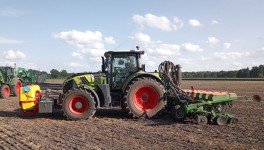How to get good nodules on your legume crop
Legumes can fix nitrogen directly from the air in symbiosis with rhizobial bacteria. To achieve perfect root nodulation, one million LIVING rhizobia must be present on each seed at the time of planting. How can this be achieved?
Product quality: Use well approved inoculants only!
- There are still products on the market that do not work or that are unreliable
- For soya, luckily, there are good government trials since several years, e.g. from the LTZ (german)
- For the other crop types we mostly have to rely on the experience of the pulse growing community
- LegumeFix and LiquiFix reliably yield excellent results both in trials as on thousands of farms since many years
- Keep an eye on the date of expiry. For most dealers inoculants are still an irrelevant niche; sometimes old product is being sold without noticing
Accuracy. This is what Rhizobia do NOT like:
- Heat and frost
- Direct sunlight
- Baktericides (chlorinated water, certain seed treatments)
- Pressure above 30 PSI
- Competing other bacteria: Once opened, store inoculants in the fridge and use them soo. Plant seed soon after inoculation
- Dehydration: Close open peat units well. Adjust depth of planting and recompaction to make sure inoculated seed lies in moist soil
Application: How to distribute the inoculant EVENLY on seed:
- Mix the inoculant slowly, bit by bit, into the seed
- Small amounts of seed are best inoculated by hand in a bucket
- For big volumes I recommend the following methods
Well-approved inoculation methods
Seed inoculation requires some care and a little bit of time. Besides that it is quite simple.
Big Legume seed (especially soya) is fragile, therefore:
- Avoid high and hard drops
- Run mixers slowly and just as long as necessary
- Make sure there is enough space between paddles and wall of mixer
- Only use augers that are adequate for big, sensitive seed
Dry inoculation (LegumeFix, HiStick)
The peat sticks better when seed is lightly dampened. Therefore:
- Mix the seed thoroughly with 2 ml/kg water
- Add the peat bit by bit until all seed is evenly coloured brownish
- Plant within 24 hours
- For pneumatic planters lemonade can be used instead of water for better stickiness
For big acreages it can be interesting to apply the peat directly into the furrow with a granulate caster. Please contact me for details if this is interesting for you.
Liquid inoculation (LiquiFix, Rhizoliq etc.)
Application with a (concrete-) mixer
- Run the mixer with the seed SLOWLY
- Add the liquid bit by bit
- Stop as soon as all seed is evenly moistened
- The moisture disappears quickly. When using LiquiFix you can plant right after application without risk of clumping seed
Application with the spraycan - very easy and efficient
- Let the seed run from one bigbag to another, using two forklifts
- Use a simple compressor-run spraycan (30 € in the building centre) to spray the liquid down into the falling seed in the lower bigbag
- IMPORTANT: Perfect distribution is achieved after 3-4 circulations only
- IMPORTANT: Put the pressure on the compressor and on the contraction choke as low as possible to preserve the rhizobia
This might sound complicated but has proven very simple on many farms. One full bigbag of seed is perfectly inoculated in 15 minutes, with zero seed damage. A detailled description of the method is published here.
Direct inoculation with a contraction choke into the furrow - very interesting on big acreages
This method requires an investment into a front-tank, adjustment system etc. Yet I expect it to become the leading technology for big farms.
- Depending on the technology put 50-150 litres of water into the front-tank
- Stir LiquiFix into the water just prior to planting
- Spray the mix directly into the furrow while plantingIMPORTANT: Like for the Spraycan-application the pressure must not be too high.
Which legume crops must be inoculated?
In some crops inoculation has a strong effect most of the times, in others just sometimes. After a long brake of a crop on a field inoculation is mostly worthwhile - after short breaks this depends. Rhizobial survival in the soil depends much on the location (pH, humus content and -quality etc.):
Soya and Chickpea
For these "new" crops inoculation is a must in first cultivation and strongly recommended even after several cultivation cycles on a field.
Lupin and Lucerne/Alfalfa
These legumes should always be inoculated when grown for the first time or after a long break on an field. Many growers report they have good effects even after several times of cultivation - other locations there is no visible effect of inoculation once the rhizobia are established in the soil.
Pea/Peavine and Faba/Lentil/Vetch
These crops all cooperate with the same type of Rhizobia (Rhizobacterium leguminosarum spp). Due to the historically big presence of this group of plants both as cultural- and as weed-species, this type of rhizobia is established in most european soils. On some locations inoculation still has a good effect - a simple trial will give you an idea.
More in-depth information on biological n-fixation can be found here.
The australian GRDC has specialised in legume inoculation since decades. They recently published a marvellous "Pocket Guide". Even more detailled information can be found in their somewhat older "Practical Guide".
Sojaförderring provides detailed information on the inoculation of soya (in german).
If you have any questions about inoculants and/or inoculation procedures, please give me call.











LegumiN | Fabian von Beesten | Körtlinghausen 8 | D-59602 Rüthen
